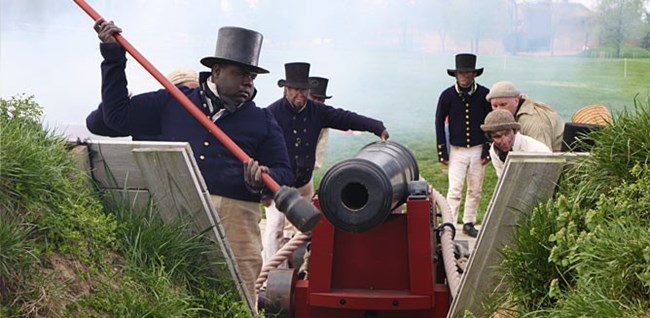
After the Revolutionary War, the federal government had reduced the military. President James Madison, like his predecessor Thomas Jefferson, believed that keeping a large standing military was too costly and could threaten the young democracy. By some estimates Great Britain had 30 commissioned ships for every 1 in the American navy at the start of the war. America’s standing army was only about half the size of Great Britain’s. Most of America’s army was concentrated on the US border to the north, leaving most of the defense of the rest of the nation in the hands of the local militia. The navy was augmented by hundreds of privateers—infamous for their harassment of British merchant ships (capturing at least 1400); and the regular army was augmented by some 458,000 volunteer militia—citizen-soldiers who would be called upon to defend their homeland. Nevertheless, the United States was ill-prepared to take on a world super-power. Facing the UnexpectedThe US Army had far more territory to defend than during the Revolutionary War. Thus much of the country was defended by generally poorly equipped and trained militia led by generally inexperienced officers. Recognizing this vulnerability, the British planned a three-pronged strategy against the Americans: Attack from the north and separate New England from the rest of the United States; attack New Orleans and gain control of the Mississippi River; and secure the Chesapeake Bay region, the nation’s political and economic hub.Meanwhile, the Royal Navy maintained a blockade of the American coast to impede commerce and bring economic hardship to the country. The United States would have to divide its meager forces among these several fronts. The Americans had a strategy, too. They planned to take advantage of Britain’s preoccupation with the war with Napoleon in Europe. With the bulk of Britain’s military focused on that conflict, the United States would take the offensive and invade Great Britain’s Canadian territories. The Americans expected an easy victory and believed the British would concede in order to get their territory back. What the Americans did not expect was that the US invasion of the Canadas, as the British colonies were then known, would fail; that Great Britain would end the war in Europe and turn full attention to the North American conflict; and that a costly war would play out on the home front for three horrific years. Expanding the MilitaryThe War of 1812, particularly the battles and British raids in the Chesapeake region, convinced Americans that they needed a stronger military and a central command.The country needed a navy large enough to protect the nation’s economically vital waterways and coastline. The United States realized that without this stronger coastal defense, it was vulnerable to attacks and blockades that impeded trade. The war also proved the nation could not depend on militia and needed a stronger regular army. During conflicts in the Chesapeake region, local militia sometimes performed bravely, but there were many times when they were weak, undependable, or missing. The War of 1812 led to defense policies that shaped the American military establishment for years to come. For the rest of the 1800s, coastal defense and large warship construction dominated American defense spending. |
Last updated: June 4, 2020
